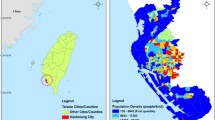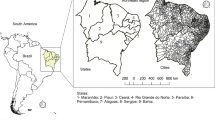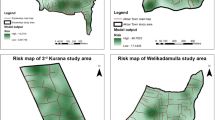Abstract
During the span of August–October, 2017 a major outbreak of Dengue fever happened in Khyber Pakhtunkhwa province of Pakistan. Cases were reported from all the major cities and rural areas, but Peshawar was more severely hit with more than half of the total cases belonging to central Peshawar city. The epidemic patterns reveal that dengue fever cases were mostly reported for plain areas and also low altitude mountainous regions. We employed the principle of maximum entropy to establish the underlying distribution of dengue presences and background data. A geostatistical analysis was conducted by modelling the spatial structure of the dengue fever risk and estimating the prediction maps with corresponding uncertainty taking into account some of the most significant covariates. The prediction maps were created using binomial kriging with a binary logistic drift. The analysis was carried out for the whole province as well as subregions to have a closer look of the spatial distribution at local level. Our results show that our methodology performed well. Vector distribution, population density, and distance to roads were found to significantly affecting the spatial distribution of risk and gives very informative pattern.








Similar content being viewed by others
References
Akiner MM, Demirci B, Babuadze G, Robert V, Schaffner F (2016) Spread of the invasive mosquitoes Aedes aegypti and Aedes albopictus in the black sea region increases risk of chikungunya, dengue, and zika outbreaks in europe. PLoS Negl Trop Dis 10(4):e0004664
Ali A, Zaidi F, Fatima SH, Adnan M, Ullah S (2018) Spatial modeling of rat bites and prediction of rat infestation in peshawar valley using binomial kriging with logistic regression. Environ Monit Assess 190(4):245
Anderson JR, Rico-Hesse R (2006) Aedes aegypti vectorial capacity is determined by the infecting genotype of dengue virus. Am J Trop Med Hyg 75(5):886–892
Arlot S, Celisse A (2010) A survey of cross-validation procedures for model selection. Stat Surv 4:40–79
Bancroft TL (1906) On the aetiology of dengue fever. Aust Med Gaz 25:17–18
Banu S, Hu W, Hurst C, Tong S (2011) Dengue transmission in the asia-pacific region: impact of climate change and socio-environmental factors. Trop Med Int Health 16(5):598–607
Barbet-Massin M, Jiguet F, Albert CH, Thuiller W (2012) Selecting pseudo-absences for species distribution models: how, where and how many? Methods Ecol Evolut 3(2):327–338
Bernier UR, Kline DL, Barnard DR, Schreck CE, Yost RA (2000) Analysis of human skin emanations by gas chromatography/mass spectrometry. 2. Identification of volatile compounds that are candidate attractants for the yellow fever mosquito (Aedes aegypti). Anal Chem 72(4):747–756
Bharaj P, Chahar HS, Pandey A, Diddi K, Dar L, Guleria R, Kabra SK, Broor S (2008) Concurrent infections by all four dengue virus serotypes during an outbreak of dengue in 2006 in Delhi, india. Virol J 5(1):1
Bouma M, Dye C, Van der Kaay H (1996) Falciparum malaria and climate change in the northwest frontier province of Pakistan. Am J Trop Med Hyg 55(2):131–137
Campbell LP, Luther C, Moo-Llanes D, Ramsey JM, Danis-Lozano R, Peterson AT (2015) Climate change influences on global distributions of dengue and chikungunya virus vectors. Philos Trans R Soc B 370(1665):20140135
Chan M, Johansson MA (2012) The incubation periods of dengue viruses. PLoS One 7(11):e50972
Christensen O, Ribeiro P Jr (2002) georglm-a package for generalised linear spatial models. R-NEWS 2(2):26–28 ISSN 1609-3631
Cromley EK (2003) Gis and disease. Annu Rev Public Health 24(1):7–24
Diggle PJ, Ribeiro PJ (2007) Model-based geostatistics (Springer series in statistics), 1st edn. Springer, Berlin
Efron B (1982) The jackknife, the bootstrap, and other resampling plans, vol 38. SIAM, Philadelphia
Eisen L, Lozano-Fuentes S (2009) Use of mapping and spatial and space-time modeling approaches in operational control of Aedes aegypti and dengue. PLoS Negl Trop Dis 3(4):e411
Elong Ngono A, Shresta S (2018) Immune response to dengue and zika. Annu Rev Immunol 36:279–308
Evans JS, Ram K (2018) Package ‘spatialeco’
Fatima SH, Atif S, Rasheed SB, Zaidi F, Hussain E (2016) Species distribution modelling of Aedes aegypti in two dengue-endemic regions of Pakistan. Trop Med Int Health 21(3):427–436
Greenough PG, Nelson EL (2019) Beyond mapping: a case for geospatial analytics in humanitarian health. Confl Health 13(1):50
Gregory P (2005) Bayesian logical data analysis for the physical sciences: a comparative approach with mathematica® support. Cambridge University Press, Cambridge
Gubler DJ (1998) Dengue and dengue hemorrhagic fever. Clin Microbiol Rev 11(3):480–496
Gubler DJ (2006) Dengue/dengue haemorrhagic fever: history and current status. In: New treatment strategies for dengue and other flaviviral diseases: Novartis Foundation Symposium, vol 277. Wiley Online Library, pp 3–22
Gubler DJ, Meltzer M (1999) Impact of dengue/dengue hemorrhagic fever on the developing world. In: Maramorosch K, Murphy FA, Shatkin AJ (eds) Adv Virus Res, vol 53. Elsevier, Amsterdam, pp 35–70
Guzman MG, Harris E (2015) Dengue. The Lancet 385(9966):453–465
Haider Z, Ahmad FZ, Mahmood A, Waseem T, Shafiq I, Raza T, Qazi J, Siddique N, Humayun MA (2015) Dengue fever in pakistan: a paradigm shift; changing epidemiology and clinical patterns. Perspect Public Health 135(6):294–298
Hampton KH, Serre ML, Gesink DC, Pilcher CD, Miller WC (2011) Adjusting for sampling variability in sparse data: geostatistical approaches to disease mapping. Int J Health Geogr 10(1):54
He J, Kolovos A (2018) Bayesian maximum entropy approach and its applications: a review. Environ Res Risk Assess 32(4):859–877
Henchal EA, Putnak JR (1990) The dengue viruses. Clin Microbiol Rev 3(4):376–396
Hengl T (2009) A practical guide to geostatistical mapping, 2nd edn. University of Amsterdam, Amsterdam
Hengl T (2017) GSIF: global soil information facilities. R package version 0.5-4
Isaaks EH, Srivastava RM (1990) An introduction to applied geostatistics. Oxford University Press, Oxford
Jan FA, Ishaq M, Khan S, Ihsanullah I, Ahmad I, Shakirullah M (2010) A comparative study of human health risks via consumption of food crops grown on wastewater irrigated soil (Peshawar) and relatively clean water irrigated soil (lower dir). J Hazard Mater 179(1–3):612–621
Jansen CC, Beebe NW (2010) The dengue vector Aedes aegypti: what comes next. Microbes Infect 12(4):272–279
Jaynes ET (1957) Information theory and statistical mechanics. Phys Rev 106(4):620
Kannan R, Ramakrishnan K, Ojo AO (2019) Social networking sites as communication tool for dengue related healthcare and wellness information. In: Proceedings of the 2nd international conference on software engineering and information management. ACM, pp 204–207
Khalid B, Ghaffar A (2015) Environmental risk factors and hotspot analysis of dengue distribution in Pakistan. Int J Biometeorol 59(11):1721–1746
Kittayapong P, Yoksan S, Chansang U, Chansang C, Bhumiratana A (2008) Suppression of dengue transmission by application of integrated vector control strategies at sero-positive GIS-based foci. Am J Trop Med Hyg 78(1):70–76
Kuno G (2009) Emergence of the severe syndrome and mortality associated with dengue and dengue-like illness: historical records (1890 to 1950) and their compatibility with current hypotheses on the shift of disease manifestation. Clin Microbiol Rev 22(2):186–201
Li R, Xu L, Bjørnstad ON, Liu K, Song T, Chen A, Xu B, Liu Q, Stenseth NC (2019) Climate-driven variation in mosquito density predicts the spatiotemporal dynamics of dengue. Proc Natl Acad Sci 116(9):3624–3629
Messina JP, Brady OJ, Golding N, Kraemer MU, Wint GR, Ray SE, Pigott DM, Shearer FM, Johnson K, Earl L, Marczak LB, Shirude S, Davis Weaver N, Gilbert M, Velayudhan R, Jones P, Jaenisch T, Scott TW, Reiner RC, Hay SI (2019) The current and future global distribution and population at risk of dengue. Nature Microbiol 4(9):1508–1515
Miller J, Franklin J, Aspinall R (2007) Incorporating spatial dependence in predictive vegetation models. Ecol Model 202(3):225–242
Mustafa M, Rasotgi V, Jain S, Gupta V (2015) Discovery of fifth serotype of dengue virus (DENV-5): a new public health dilemma in dengue control. Med J Armed Forces India 71(1):67–70
Oliver M, Webster R (2014) A tutorial guide to geostatistics: computing and modelling variograms and kriging. Catena 113:56–69
World Health Organization et al (2014) Dengue and severe dengue. Technical report, World Health Organization. Regional Office for the Eastern Mediterranean
Pandey BD, Nabeshima T, Pandey K, Rajendra SP, Shah Y, Adhikari BR, Gupta G, Gautam I, Tun MM, Uchida R et al (2013) First isolation of dengue virus from the 2010 epidemic in nepal. Trop Med Health 41(3):103–111
Patz JA, Martens W, Focks DA, Jetten TH (1998) Dengue fever epidemic potential as projected by general circulation models of global climate change. Environ Health Perspect 106(3):147–153
Phillips SJ, Anderson RP, Schapire RE (2006) Maximum entropy modeling of species geographic distributions. Ecol Model 190(3):231–259
Phillips SJ, Dudík M, Schapire RE (2004) A maximum entropy approach to species distribution modeling. In: Proceedings of the twenty-first international conference on machine learning. ACM, p 83
R Core Team (2017) R: a language and environment for statistical computing. R Foundation for Statistical Computing, Vienna, Austria
Rasheed S, Butlin R, Boots M (2013) A review of dengue as an emerging disease in Pakistan. Public Health 127(1):11–17
Reiner Jr RC, Stoddard ST, Vazquez-Prokopec GM, Astete H, Perkins TA, Sihuincha M, Stancil JD, Smith DL, Kochel TJ, Halsey ES et al (2019) Estimating the impact of city-wide aedes aegypti population control: an observational study in Iquitos, Peru. PLoS Negl Trop Dis 13(5):e0007255
Ribeiro Jr PJ, Christensen OF, Diggle PJ (2003) geoR and geoRglm: software for model-based geostatistics. Technical University Vienna, Vienna, pp 517–524
Roberts GO, Rosenthal JS (1998) Optimal scaling of discrete approximations to Langevin diffusions. J R Stat Soc Ser B (Stat Methodol) 60(1):255–268
Rosen L (1996) Dengue hemorrhagic fever. Bulletin de la Societe de pathologie exotique (1990) 89(2):91–3
Salim ZT, Hashim U, Arshad MM, Fakhri MA, Salim ET (2017) Frequency-based detection of female aedes mosquito using surface acoustic wave technology: early prevention of dengue fever. Microelectron Eng 179:83–90
Sánchez-Hernández D, Aguirre-Salado CA, Sánchez-Díaz G, Aguirre-Salado AI, Soubervielle-Montalvo C, Reyes-Cárdenas O, Reyes-Hernández H, Santana-Juárez MV (2019) Modeling spatial pattern of dengue in North Central Mexico using survey data and logistic regression. Int J Environ Health Res. https://doi.org/10.1080/09603123.2019.1700938
Shah S (2011) Conservation of endangered species in Khyber Pakhtunkhwa. J Anim Plant Sci 21(2):400–404
Simmons CP, Farrar JJ, van Vinh Chau N, Wills B (2012) Dengue. N Engl J Med 366(15):1423–1432
Sinton J et al (1917) The anopheline mosquitos of the Kohat district. Indian J Med Res 5(1):195–209
Suleman M, Arshad M, Khan K (1996) Yellowfever mosquito (Diptera: Culicidae) introduced into Landi Kotal, Pakistan, by tire importation. J Med Entomol 33(4):689–693
Tatem AJ (2017) Worldpop, open data for spatial demography. Sci Data 4:1–4
Van Kleef E, Bambrick H, Hales S (2010) The geographic distribution of dengue fever and the potential influence of global climate change. TropIKA. net
Webster R, Oliver MA (2008) Geostatistics for environmental scientists, 2nd edn. Wiley, England
Wesolowski A, Qureshi T, Boni MF, Sundsøy PR, Johansson MA, Rasheed SB, Engø-Monsen K, Buckee CO (2015) Impact of human mobility on the emergence of dengue epidemics in Pakistan. Proc Natl Acad Sci 112(38):11887–11892
WorldClim (website). Global climate data; free climate data for ecological modeling and GIS. http://www.worldclim.org/bioclim
Wu P-C, Lay J-G, Guo H-R, Lin C-Y, Lung S-C, Su H-J (2009) Higher temperature and urbanization affect the spatial patterns of dengue fever transmission in subtropical Taiwan. Sci Total Environ 407(7):2224–2233
Xi Z, Ramirez JL, Dimopoulos G (2008) The Aedes aegypti toll pathway controls dengue virus infection. PLoS Pathog 4(7):e1000098
Yousaf MZ, Siddique A, Ashfaq UA, Ali M et al (2018) Scenario of dengue infection & its control in Pakistan: an up-date and way forward. Asian Pac J Trop Med 11(1):15
Yu HL, Angulo JM, Cheng MH, Wu J, Christakos G (2014) An online spatiotemporal prediction model for dengue fever epidemic in Kaohsiung (Taiwan). Biom J 56(3):428–440
Yu HL, Yang SJ, Yen HJ, Christakos G (2011) A spatio-temporal climate-based model of early dengue fever warning in southern Taiwan. Stoch Environ Res Risk Assess 25(4):485–494
Zaidi F, Fatima SH, Khisroon M, Gul A (2016) Distribution modeling of three screwworm species in the ecologically diverse landscape of North West Pakistan. Acta Trop 162:56–65
Acknowledgements
Asad Ali is thankful to Prof Dr. Mukhtiar Ali Medical Director of Mardan Medical Complex KP, and Dr Tariq Hayat Taj Dengue Control Program Khyber Pakhtunkhwa (2016-17) for providing data on dengue cases.
Author information
Authors and Affiliations
Corresponding author
Additional information
Publisher's Note
Springer Nature remains neutral with regard to jurisdictional claims in published maps and institutional affiliations.
Rights and permissions
About this article
Cite this article
Ahmad, H., Ali, A., Fatima, S.H. et al. Spatial modeling of Dengue prevalence and kriging prediction of Dengue outbreak in Khyber Pakhtunkhwa (Pakistan) using presence only data. Stoch Environ Res Risk Assess 34, 1023–1036 (2020). https://doi.org/10.1007/s00477-020-01818-9
Published:
Issue Date:
DOI: https://doi.org/10.1007/s00477-020-01818-9




